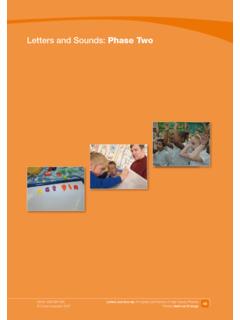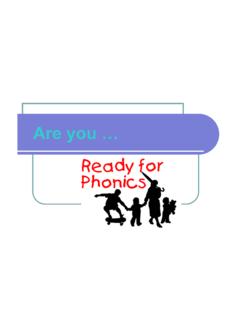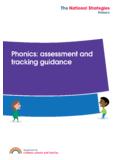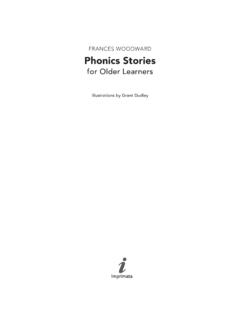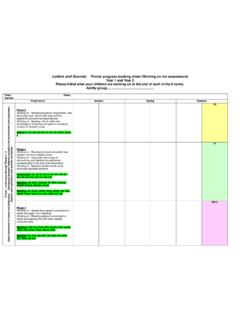Transcription of Letters and sounds: Phase Three
1 00281-2007 BKT-EN Crown copyright 2007 Letters and Sounds: Principles and Practice of High Quality PhonicsPrimary National Strategy Letters and sounds: Phase Three Letters and Sounds: Principles and Practice of High Quality PhonicsPrimary National Strategy00281-2007 BKT-EN Crown copyright 2007 Letters and Sounds: Phase ThreePhase Three (up to weeks)Contents PageSummary 74 Suggested daily teaching in Phase Three 75 Suggested timetable for Phase Three discrete teaching 76 Teaching sets 6 and 7 Letters 78 Teaching letter names (if not already taught) 80 Introducing and teaching two- letter and Three - letter GPCs 81 Practising grapheme recognition (for reading) and recall (for spelling) 82 Practising blending for reading 85 Practising segmentation for spelling 88 Teaching and practising high-frequency (common)
2 Words 91 Teaching reading and spelling two-syllable words 94 Practising reading and writing captions and sentences 95 Assessment 99 Bank of suggested words, captions and sentences 100 KeyThis icon indicates that the activity can be viewed on the DVD. 00281-2007 BKT-EN Crown copyright 2007 Letters and Sounds: Principles and Practice of High Quality PhonicsPrimary National StrategyLetters and Sounds: Phase Three SummaryChildren entering Phase Three will know around 19 Letters and be able to blend phonemes to read VC words and segment VC words to spell. While many children will be able to read and spell CVC words, they all should be able to blend and segment CVC words orally. (See Appendix 3: Assessment).
3 The purpose of this Phase is to teach another 25 graphemes, most of them comprising two Letters ( oa), so the children can represent each of about 42 phonemes by a grapheme (the additional phoneme /zh/ found in the word vision will be taught at Phase Five). Children also continue to practise CVC blending and segmentation in this Phase and will apply their knowledge of blending and segmenting to reading and spelling simple two-syllable words and captions. They will learn letter names during this Phase , learn to read some more tricky words and also begin to learn to spell some of these teaching materials in this Phase suggest an order for teaching Letters and provide a selection of suitable words made up of the Letters as they are learned and captions and sentences made up of the words.
4 They are for using in the activities practising blending for reading and segmenting for spelling. These are not lists to be worked through slavishly but to be selected from as needed for an must always be remembered that phonics is the step up to word recognition. Automatic reading of all words decodable and tricky is the ultimate : jvwx*Set :yz, zzqu**The sounds traditionally taught for the Letters x and qu (/ks/ and /kw/) are both two phonemes, but children do not need to be taught this, at this stage as it does not affect how the Letters are wordsGraphemesSample wordschchiparfarmshshoporforththin/thenu rhurtngringowcowairainoicoineefeeteardea righnightairfairoaboaturesureooboot/look ercorner Letters and Sounds: Principles and Practice of High Quality PhonicsPrimary National Strategy00281-2007 BKT-EN Crown copyright 2007 Letters and Sounds.
5 Phase ThreeSuggested daily teaching in Phase ThreeSequence of teaching in a discrete phonics sessionIntroduction Objectives and criteria for successRevisit and reviewTeachPractiseApplyAssess learning against criteriaRevisit and reviewPractise previously learned Letters or graphemesTeachTeach new graphemesTeach one or two tricky wordsPractisePractise blending and reading words with a new GPCP ractise segmenting and spelling words with a new GPCA pplyRead or write a caption or sentence using one or more tricky words and words containing the graphemes 00281-2007 BKT-EN Crown copyright 2007 Letters and Sounds: Principles and Practice of High Quality PhonicsPrimary National StrategyLetters and Sounds: Phase Three Suggested timetable for Phase Three discrete teachingWeek Practise previously learned Letters and sounds Teach set 6 Letters and sounds Learn an alphabet song Practise blending for reading Practise segmentation for spelling Practise reading high-frequency words Read sentences using sets 1 6 Letters and the tricky words no, go, I, the, toWeek Practise previously learned Letters and sounds Teach set 7 Letters and sounds Point to the Letters in the alphabet while singing the alphabet song Practise blending for reading Practise segmentation for spelling Teach reading the tricky words he.
6 She Practise reading and spelling high-frequency words Teach spelling the tricky words the and to Practise reading captions and sentences with sets 1 7 Letters and he, she, no, go, I, the, toWeek Practise previously learned GPCs Teach the four consonant digraphs Point to the Letters in the alphabet while singing the alphabet song Practise blending for reading Practise segmentation for spelling Teach reading the tricky words we, me, be Practise reading and spelling high-frequency words Practise reading two-syllable words Practise reading captions and sentences Practise writing captions and sentencesWeek Practise previously learned GPCs Teach four of the vowel digraphs Point to the Letters in the alphabet while singing the alphabet song Practise blending for reading Practise segmentation for spelling Teach reading the tricky word was Teach spelling the tricky words no and go Practise reading and spelling high-frequency words Practise reading two-syllable words Practise reading captions and sentences Practise writing captions and sentencesWeek
7 Practise previously learned GPCs Teach four more vowel digraphs Point to the Letters in the alphabet while singing the alphabet song Letters and Sounds: Principles and Practice of High Quality PhonicsPrimary National Strategy00281-2007 BKT-EN Crown copyright 2007 Letters and Sounds: Phase Three Practise blending for reading Practise segmentation for spelling Teach reading the tricky word my Practise reading and spelling high-frequency words Teach spelling two-syllable words Practise reading captions and sentences Practise writing captions and sentencesWeek Practise previously learned GPCs Teach four more vowel digraphs Practise letter names Practise blending for reading Practise segmentation for spelling Teach reading the tricky word you Practise reading and spelling high-frequency words Practise spelling two-syllable words Practise reading captions and sentences Practise writing captions and
8 SentencesWeek Practise previously learned GPCs Teach four more vowel digraphs Practise letter names Practise blending for reading Practise segmentation for spelling Teach reading the tricky word they Practise reading and spelling high-frequency words Practise spelling two-syllable words Practise reading captions and sentences Practise writing captions and sentencesWeek Practise all GPCs Practise letter names Practise blending for reading Practise segmentation for spelling Teach reading the tricky word her Practise reading and spelling high-frequency words Practise spelling two-syllable words Practise reading captions and sentences Practise writing captions and sentencesWeek Practise all GPCs Practise letter names Practise blending for reading Practise segmentation for spelling Teach reading the tricky word all Practise reading and spelling high-frequency words Practise spelling two-syllable words Practise reading captions and sentences Practise writing captions and sentences 00281-2007 BKT-EN Crown copyright 2007 Letters and Sounds: Principles and Practice of High Quality PhonicsPrimary National StrategyLetters and Sounds.
9 Phase Three Week 0 Practise all GPCs Practise letter names Practise blending for reading Practise segmentation for spelling Teach reading the tricky word are Practise reading and spelling words Practise spelling two-syllable high-frequency words Practise reading captions and sentences Practise writing captions and sentencesWeeks More consolidation if necessary, or move on to Phase sets and lettersTeaching a letterThree-part example session for teaching the letter yPurposeTo learn to say a discrete phoneme, recognise and write the letter that represents that phonemeResourcesYoyoCard showing, on one side, a picture of a yoyo (mnemonic) with the letter y superimposed in black on the yoyo; on the other side, the letter ySmall whiteboards, pens and wipes or paper and pencils for each childProcedureHear it and say itMake a y-y-y-y noise as you produce a yoyo from behind your to say y in time to the movement of the the children to stand up and pretend to play with a yoyo, saying y each time the yoyo goes any children in the room have names with the y sound in them, say their names, accentuating the y ( YYYY olande, YYYY asmine).
10 Do the same with other words ( yes, yellow, accepting suggestions from the children if they offer them. Letters and Sounds: Principles and Practice of High Quality PhonicsPrimary National Strategy00281-2007 BKT-EN Crown copyright 2007 Letters and Sounds: Phase ThreeSee it and say itDisplay the picture of a the children to repeat your finger down and round the yoyo and down the string, saying y-y-y and saying yoyo when you reach the curled bit of the a number of times, encouraging the children to join y next to the yoyo and say the children to repeat to the yoyo and say yoyo and to the y and say with the children joining the card behind your back. Then show the yoyo side of the card and ask the children to say yoyo; show the y side of the card and the children say y-y-y-y-y-y.)
